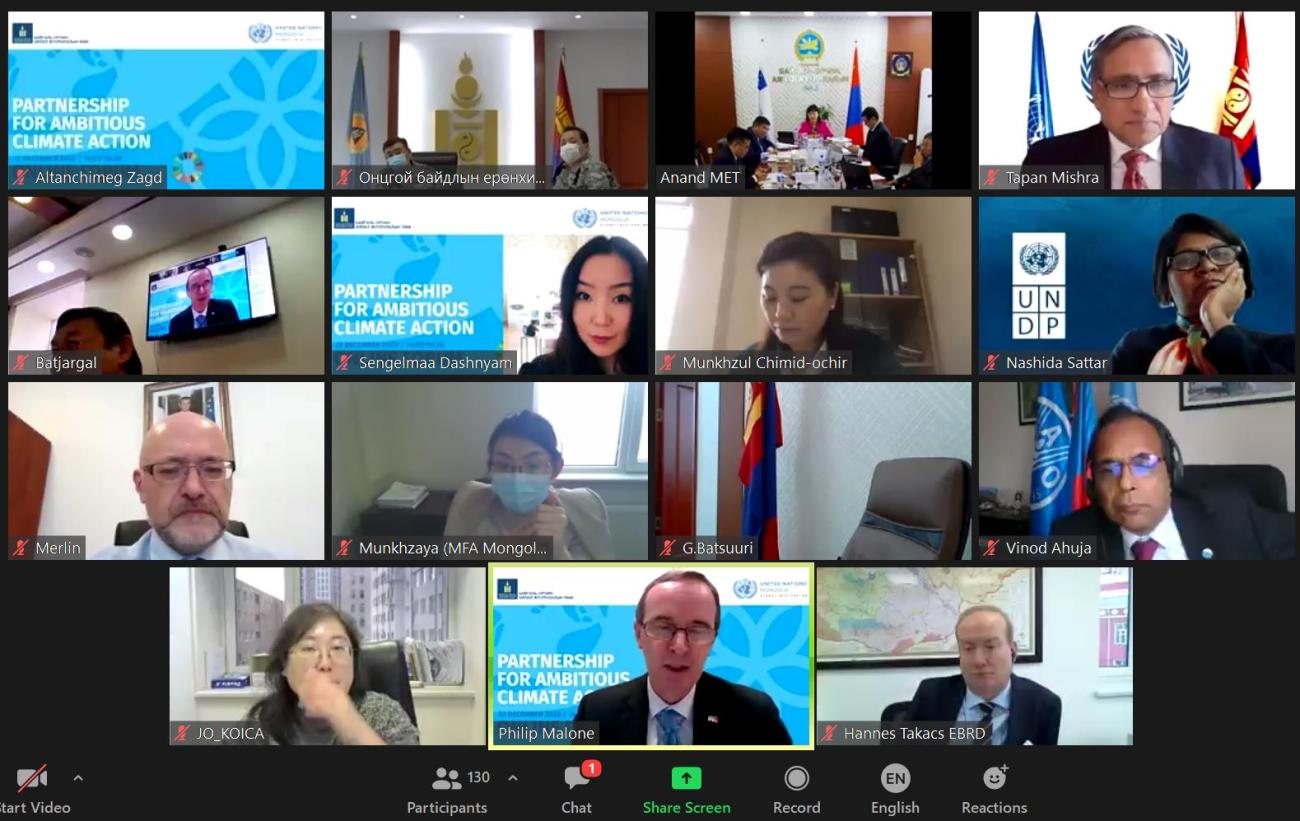The President of Mongolia, H.E Battulga Khaltmaa announced a new Nationally Determined Contributions (NDC) pledge with the mitigation target of 27.2% emission reduction by 2030 to deliver on the Paris Agreement at the recent Climate Ambition Summit 2020, co-hosted by the UN, United Kingdom and France, in partnership with Chile and Italy.
The new target is ambitious and can be achieved only if there are drastic mitigation and adaptation measures are in place. Although Mongolia contributes only to a small fraction of the global greenhouse gas (GHG) emissions (0.09%), levels are still high in terms of emissions per capita and emissions intensity per GDP with its contribution several times higher than the global average per capita. In fact, Mongolia ranks on 8th place in terms of carbon dioxide emissions tonnes per capita according to the World Bank report. Coal remains a major contributor to local pollution and climate change, accounting for 60 per cent of all emissions in Mongolia.
According to the IMF research, when burned to generate heat or electricity, coal is 2.2 times as carbon-intensive as natural gas—that is, burning coal emits more than twice as much carbon dioxide as natural gas to generate the same amount of energy. These emissions not only degrade the environment but there is long-established evidence they are hazardous to human health.
Therefore, the Government of Mongolia would have to make tough decisions when considering policy measures to fulfil its green development commitments set in the Vision-2050, as well as under the Paris Agreement and the 2030 Agenda for Sustainable Development.
The energy and agriculture sectors are the largest GHG emitters in Mongolia, contributing to more than 80 per cent of the country’s total emissions.
The energy sector accounts for 50,08 per cent of the country’s total emissions according to the NSO 2018 data. It aims to reduce the GHG emissions by increased renewable energy sources and improved efficiency of energy production. The Ministry of the Energy’s plan is to increase renewable energy sources by 20 per cent in 2023, and by 30 per cent in 2030.
The agriculture sector contributes to 48,5 per cent of the total emissions. In order to reduce the emission in the agriculture sector, it’s important to regulate and reduce the number of livestock by encouraging more efficiency in livestock production. The Ministry of Food and Agriculture is also working to upgrade the manure management.
The strategies in the construction sector to reduce emissions are to introduce more efficient and improved fuel for the ‘ger’ settlement areas in urban centres, which has also impact on air pollution, and better insulations and retrofitting of the buildings. For this, the line ministry is working to revise the construction norms and standards.
The transport sector contributes to 6.2 per cent of the country’s GHG emissions. Main tactics by the sector in the reduction of the emissions are to switch from automobile to railway in the transportation of coal, a transition to Euro-5 standard fuel and the installation of the electric heating in the trains. The ministry is also working to regulate the import of pre-owned cars.
In addition to the above-mentioned mitigation strategies reduce GHG emissions, Mongolia is taking some measures to better adapt to climate change impacts. The melting of permafrost and glaciers and surface water shortages are among the greatest threats to the Mongolians. One of the strategies of adaptation deployed by Mongolia is to create a cascade of water reservoirs using riverbed relief to collect water from melting glaciers and snow, from extreme rainfalls to prevent flood damage and to stabilize water supply during the drought.
How does UN Mongolia collectively support Mongolia in achieving the target?
The United Nations welcomes Mongolia’s ambitious commitment and stands ready to support the Government of Mongolia and accelerate the systemic change required to reduce emissions and build resilience.
UN Mongolia is actively engaging with other stakeholders to ensure collective and coordinated support in bringing green investment and green technologies. In particular, the UN’s PAGE (Partnership for Action on Green Economy) programme brings together the expertise of five UN agencies to assist Mongolia in achieving green and sustainable development, with generous funding from the Government of Germany.
PAGE supported the National Green Development Policy (NGDP) as a basis to reframe national policies around indicators of the green economy, which was soon accompanied by an Action Plan and a Sustainable Development Vision 2030. The green development aspects have been reflected now in the Vision 2050, Mongolia’s long-term strategic policy document. This translated into policy reforms in specific sectors, such as green buildings and construction, sustainable public procurement, green economy learning, sustainable finance, waste management and green trade.
In addition, the Government Action Plan for 2020-2024 that was adopted in 2020 includes policy measures aimed at helping the country to recover greener and better from the current COVID-19 crisis. UN Mongolia’s green recovery proposal for PAGE particularly focuses on the country’s tourism industry that has been heavily hit by the COVID-19 pandemic, by offering nature-based solutions for its recovery and creating green jobs.
The PAGE is also planning to initiate a dialogue with the government of Mongolia on energy subsidy reform by implementing a comprehensive assessment of energy subsidies in the country and their impact on households, businesses, government budget, environment, etc., and providing evidence-based recommendations for energy subsidy reform.
Other UN agencies like UNESCAP, UNEP, UNDP and FAO, have been providing technical and programme support to Mongolia in strengthening its environmental policies geared to towards decarbonization and better climate action. The UN agencies, individually and collectively, are supporting Mongolia in better assessment of the climate mitigation and adaptation, improvement of standardization, and as well as strengthening the country’s capacity in reporting, monitoring and data analysis on climate actions.
What roles do other development partners play?
The online forum on Partnership for Ambitious Climate Action in Mongolia was a great opportunity to have an enriching discussion that will hopefully lead to all stakeholders having a collective understanding of what it will take for Mongolia to achieve a new NDC target and how the international community can support the country in achieving this global commitment.
These ambitious commitments will take robust collaboration between the Government of Mongolia and its multilateral and bilateral partners. At the forum, Mongolia’s major bilateral partners including the UK, Germany and France, and the multilateral donors expressed their commitment to support Mongolia to reach its ambitious target of GHS emissions reduction. In particular, these partners expressed their concerns on climate financing and recommended Mongolia to tap into the internationally available financing schemes for climate actions.








